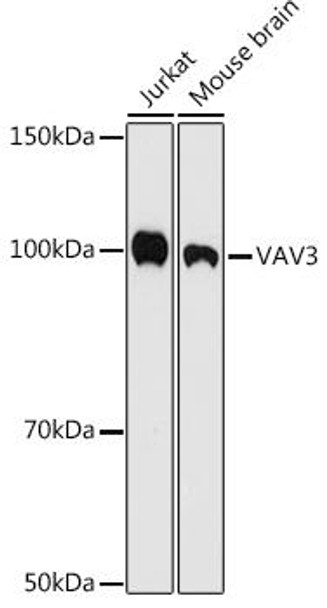Anti-VAV3 Antibody (CAB9583)
- SKU:
- CAB9583
- Product type:
- Antibody
- Antibody Type:
- Monoclonal Antibody
- Reactivity:
- Human
- Mouse
- Host Species:
- Rabbit
- Isotype:
- IgG
Description
| Product Name: | VAV3 Rabbit mAb |
| Product Code: | CAB9583 |
| Size: | 20uL, 50uL, 100uL |
| Applications: | WB, IHC |
| Reactivity: | Human, Mouse |
| Host Species: | Rabbit |
| Immunogen: | A synthesized peptide derived from human VAV3 |
| Applications: | WB, IHC |
| Recommended Dilutions: | WB 1:500 - 1:2000 IHC 1:50 - 1:200 |
| Reactivity: | Human, Mouse |
| Positive Samples: | Jurkat, Mouse brain |
| Immunogen: | A synthesized peptide derived from human VAV3 |
| Purification Method: | Affinity purification |
| Storage: | Store at -20°C. Avoid freeze / thaw cycles. Buffer: PBS with 0.02% sodium azide, 0.05% BSA, 50% glycerol, pH7.3. |
| Isotype: | IgG |
| Sequence: | Email for sequence |
| Gene ID: | 10451 |
| Uniprot: | Q9UKW4 |
| Calculated MW: | 98kDa |
| Observed MW: | 98KDa |
| UniProt Protein Function: | VAV3: a guanine nucleotide exchange factor (GEF) that activates RhoA, RhoG and, to a lesser extent, Rac1. Binds physically to the nucleotide-free states of those GTPases. Plays an important role in angiogenesis. Its recruitment by activated EPHA2 is critical for EFNA1-induced RAC1 GTPase activation and vascular endothelial cell migration and assembly. May be important for integrin-mediated signaling, at least in some cell types. In osteoclasts, along with SYK tyrosine kinase, required for signaling through integrin alpha-v/beta-1 (ITAGV-ITGB1), a crucial event for osteoclast proper cytoskeleton organization and function. This signaling pathway involves RAC1, but not RHO, activation. Necessary for proper wound healing. In the course of wound healing, required for the phagocytotic cup formation preceding macrophage phagocytosis of apoptotic neutrophils. Responsible for integrin beta-2 (ITGB2)-mediated macrophage adhesion and, to a lesser extent, contributes to beta-3 (ITGB3)-mediated adhesion. Does not affect integrin beta-1 (ITGB1)-mediated adhesion. Interacts with the PH domain of APS. Interacts (via SH2 domains) with the phosphorylated form of EPHA2. Interacts with ROS1; constitutive interaction that mediates VAV3 phosphorylation. Down-regulated by EGF and TGF-beta. Four isoforms of the human protein are produced by alternative promoter. Isoform 1 and isoform 3 are widely expressed; both are expressed at very low levels in skeletal muscle. In keratinocytes, isoform 1 is less abundant than isoform 3. Isoform 3 is detected at very low levels, if any, in adrenal gland, bone marrow, spleen, fetal brain and spinal chord; in these tissues, isoform 1 is readily detectable. |
| UniProt Protein Details: | Protein type:Nuclear receptor co-regulator; Actin-binding; Motility/polarity/chemotaxis; Adaptor/scaffold; GEFs, Rac/Rho; GEFs Chromosomal Location of Human Ortholog: 1p13.3 Cellular Component: cytosol; plasma membrane Molecular Function:epidermal growth factor receptor binding; GTPase activator activity; guanyl-nucleotide exchange factor activity; metal ion binding; protein binding; Rac guanyl-nucleotide exchange factor activity; SH3/SH2 adaptor activity Biological Process: angiogenesis; axon guidance; B cell receptor signaling pathway; blood coagulation; ephrin receptor signaling pathway; innate immune response; integrin-mediated signaling pathway; lamellipodium biogenesis; nerve growth factor receptor signaling pathway; neutrophil chemotaxis; platelet activation; positive regulation of apoptosis; positive regulation of B cell proliferation; positive regulation of cell adhesion; positive regulation of GTPase activity; positive regulation of phosphoinositide 3-kinase activity; positive regulation of signal transduction; regulation of cell size; regulation of GTPase activity; regulation of Rho protein signal transduction; regulation of small GTPase mediated signal transduction; response to DNA damage stimulus; response to drug; small GTPase mediated signal transduction; vascular endothelial growth factor receptor signaling pathway; vesicle fusion |
| NCBI Summary: | This gene is a member of the VAV gene family. The VAV proteins are guanine nucleotide exchange factors (GEFs) for Rho family GTPases that activate pathways leading to actin cytoskeletal rearrangements and transcriptional alterations. This gene product acts as a GEF preferentially for RhoG, RhoA, and to a lesser extent, RAC1, and it associates maximally with the nucleotide-free states of these GTPases. Alternatively spliced transcript variants encoding different isoforms have been described for this gene. [provided by RefSeq, Jul 2008] |
| UniProt Code: | Q9UKW4 |
| NCBI GenInfo Identifier: | 12643372 |
| NCBI Gene ID: | 10451 |
| NCBI Accession: | Q9UKW4.1 |
| UniProt Secondary Accession: | Q9UKW4,O60498, O95230, Q9Y5X8, B1AMM0, B1APV5, B4E232 B7ZLR1, E9PQ97, |
| UniProt Related Accession: | Q9UKW4 |
| Molecular Weight: | 100,828 Da |
| NCBI Full Name: | Guanine nucleotide exchange factor VAV3 |
| NCBI Synonym Full Names: | vav guanine nucleotide exchange factor 3 |
| NCBI Official Symbol: | VAV3 |
| NCBI Protein Information: | guanine nucleotide exchange factor VAV3 |
| UniProt Protein Name: | Guanine nucleotide exchange factor VAV3 |
| Protein Family: | Guanine nucleotide exchange factor |
| UniProt Gene Name: | VAV3 |
| UniProt Entry Name: | VAV3_HUMAN |






